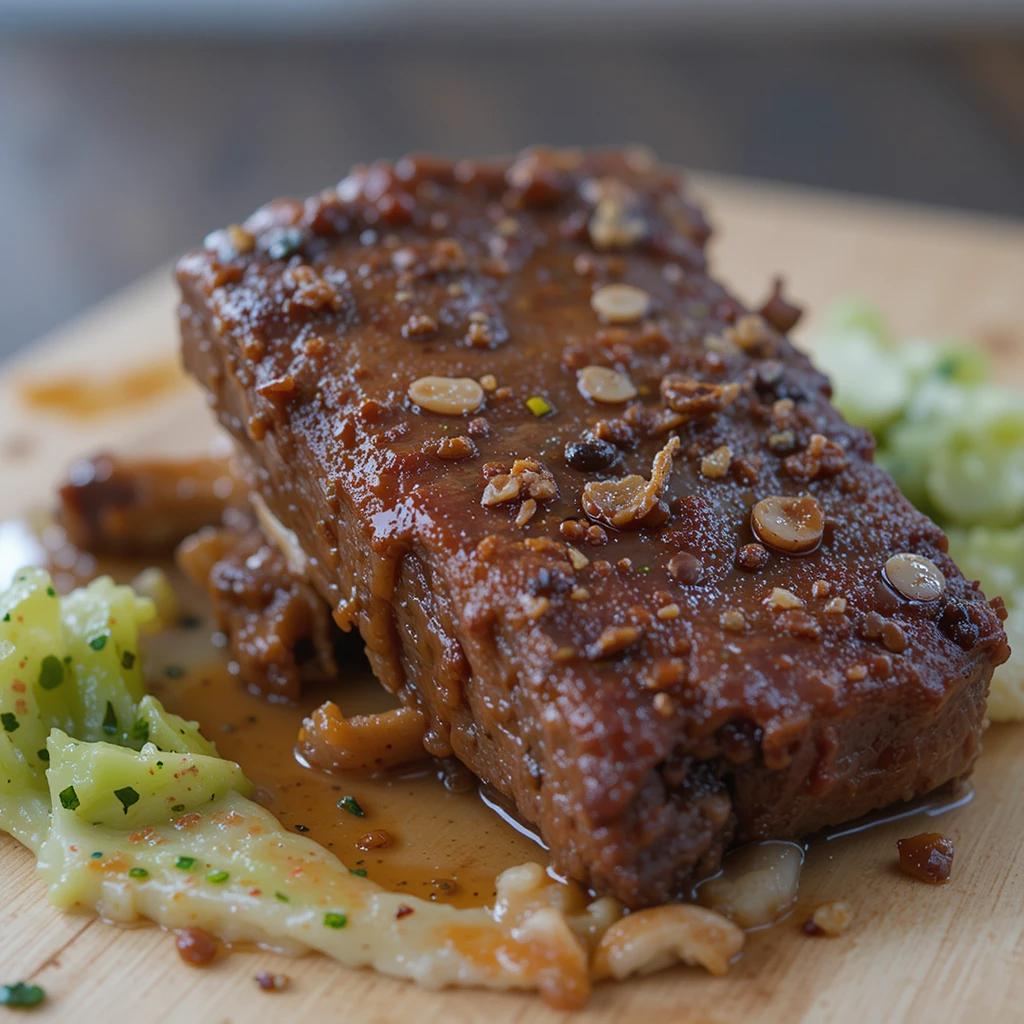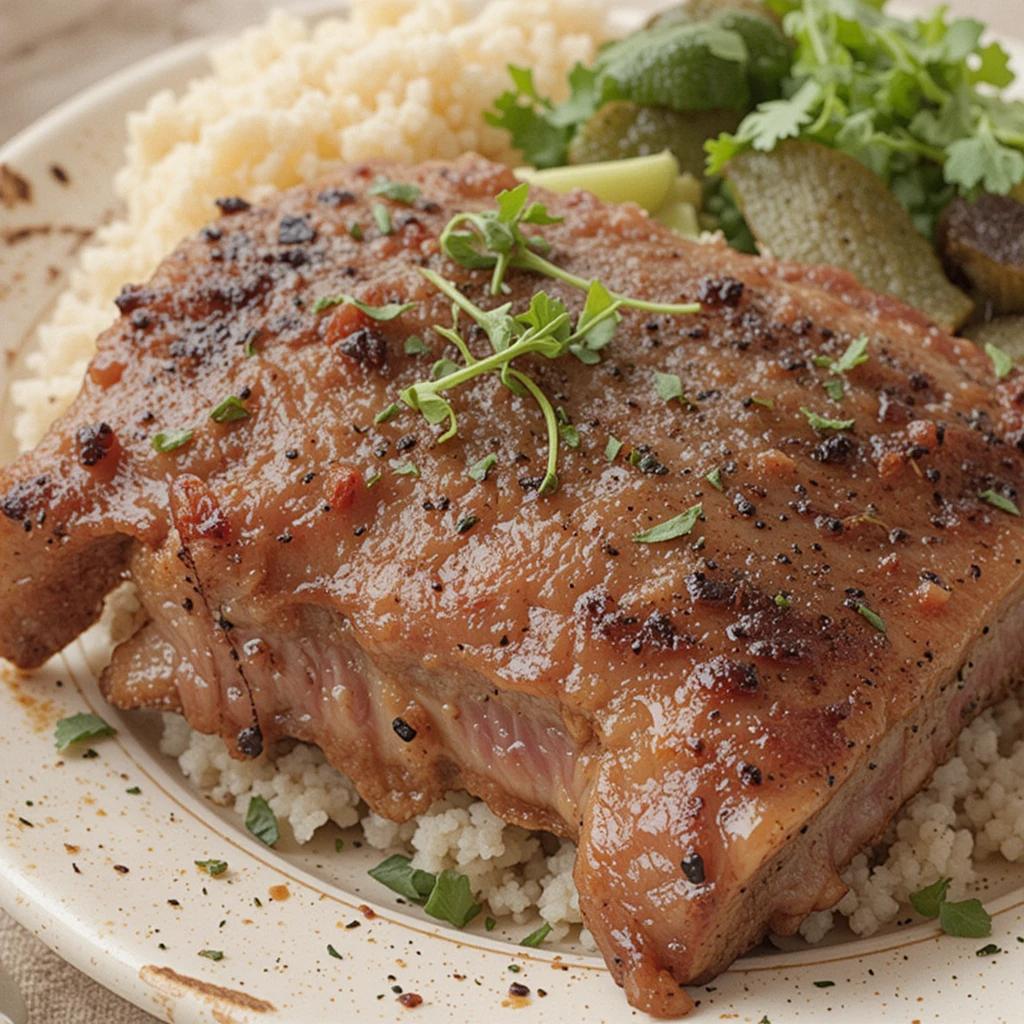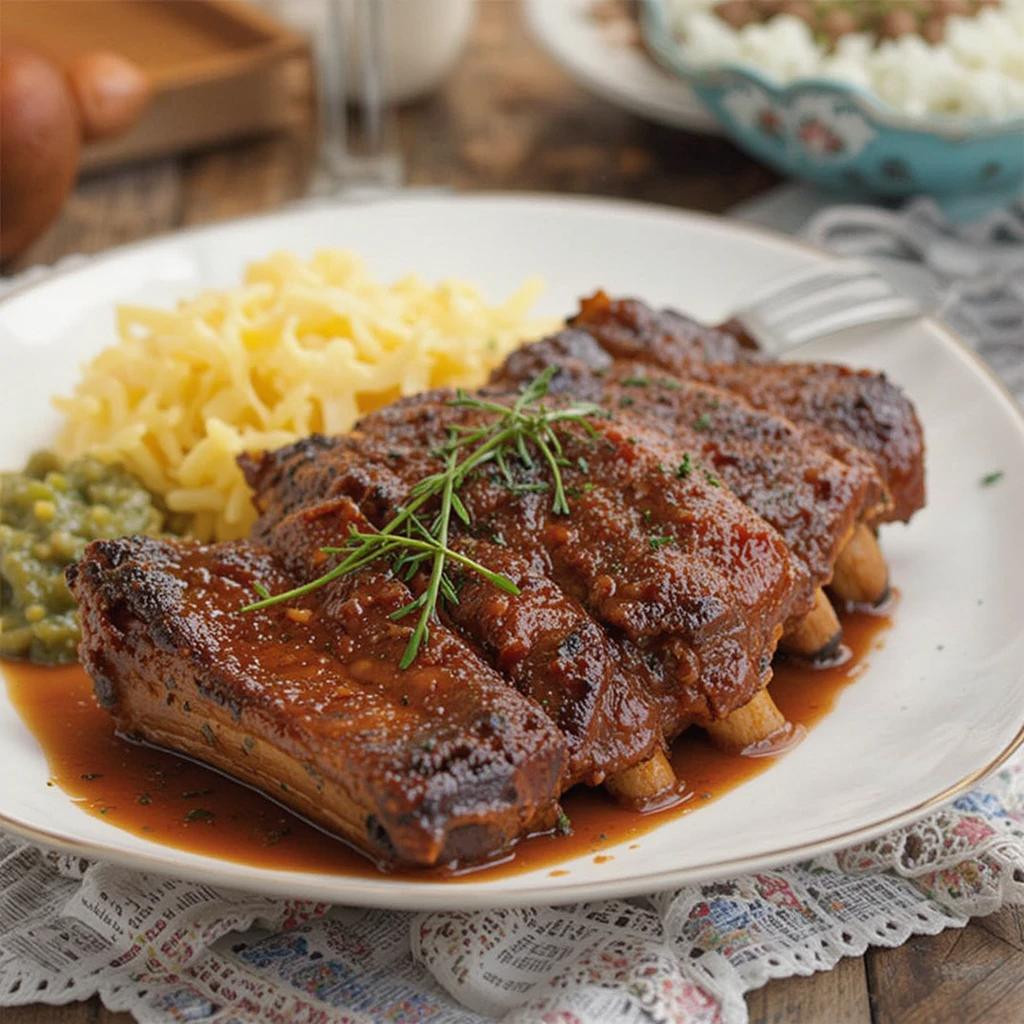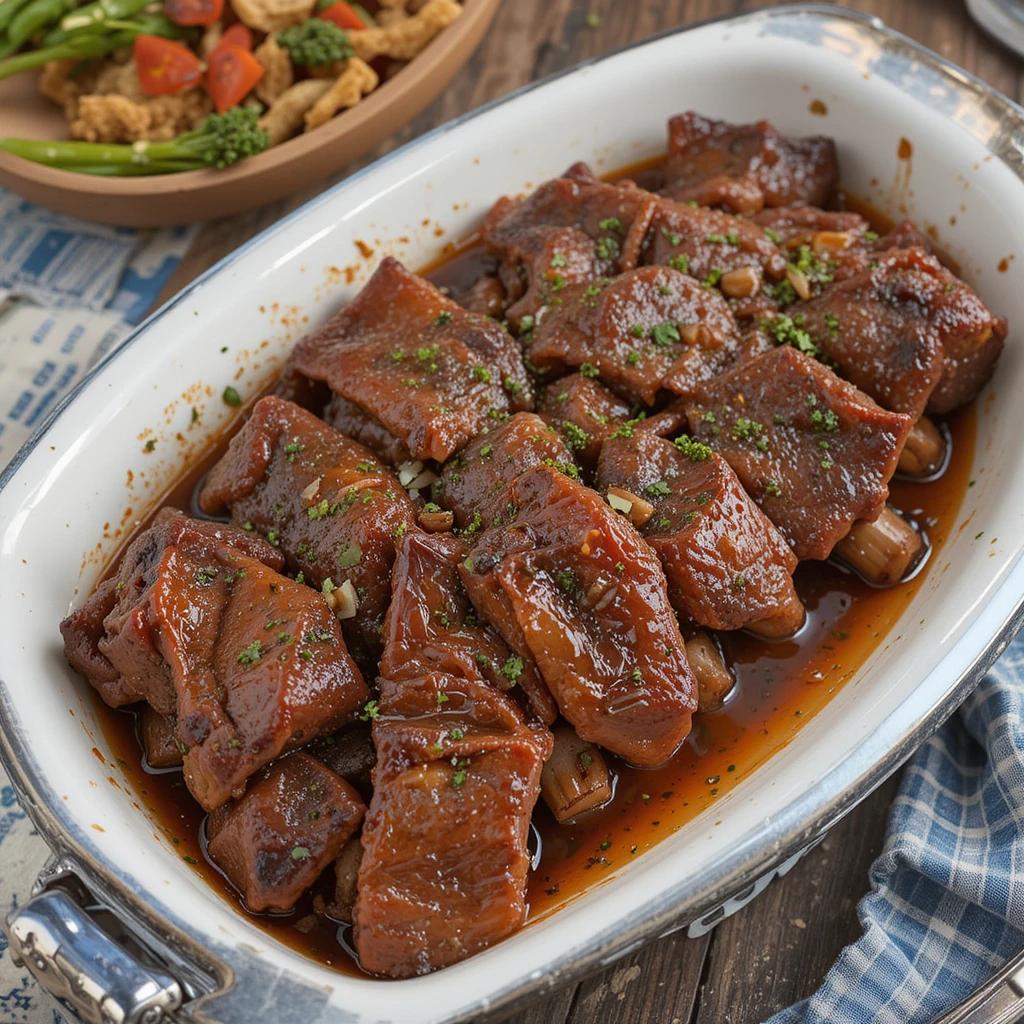Boneless beef ribs are a delectable and versatile cut of beef, loved for their rich flavor and tender texture. Despite their name, these cuts do not actually come from the rib section of the animal. Instead, they are typically sourced from the chuck or plate sections, making them a unique alternative to traditional beef ribs. Their compact size, ease of preparation, and robust taste make them a favorite for grilling, braising, or slow cooking.
Overview of Boneless Beef Ribs
Boneless beef ribs are typically rectangular strips of beef that mimic the appearance of rib meat but without the bones. They are often derived from the chuck (shoulder) or short plate (belly) area, depending on the butcher. These cuts are carefully trimmed of excess fat and connective tissue, resulting in a meaty, succulent portion of beef. Their high marbling content contributes to a flavorful and juicy bite when cooked properly.
What Makes Boneless Beef Ribs Unique?
- Bone-Free Convenience
Unlike traditional beef ribs, boneless beef ribs are more straightforward to eat and prepare. The absence of bones makes them easier to slice and serve, perfect for those who prefer a mess-free dining experience. - Rich Marbling and Flavor
Boneless beef ribs boast significant marbling, giving them a rich and buttery flavor. This quality makes them especially suitable for slow cooking methods, which allow the fat to render and the meat to become tender. - Cooking Versatility
These ribs can adapt to various cooking techniques, from high-heat grilling to low-and-slow smoking. They can also be braised in flavorful liquids or marinated to enhance their natural taste, offering endless possibilities for preparation. - Texture and Tenderness
While they require proper cooking to break down the connective tissues, boneless beef ribs reward patience with a melt-in-your-mouth texture. This tenderness sets them apart from leaner cuts like sirloin or round steak. - Affordable Alternative
Boneless beef ribs are often more budget-friendly than premium cuts like ribeye or filet mignon while delivering comparable flavor and satisfaction. They are an excellent choice for both everyday meals and special occasions.
What Are Boneless Beef Ribs?
Origin and Characteristics
Boneless beef ribs are a flavorful cut of meat derived from parts of the cow such as the chuck (shoulder) or short plate (belly), rather than the rib section as their name might suggest. They are typically trimmed into rectangular strips resembling traditional ribs. These cuts are characterized by their rich marbling, which provides a deep, beefy flavor, and a texture that can be tenderized with appropriate cooking methods.
Unlike lean cuts like sirloin, boneless beef ribs have a higher fat content, making them ideal for slow cooking techniques that enhance their tenderness. Proper preparation ensures the connective tissues break down, resulting in a melt-in-your-mouth experience.
Comparison to Bone-In Ribs
Boneless beef ribs differ significantly from bone-in ribs, both in form and cooking style:
- Convenience: Boneless beef ribs lack bones, making them easier to handle, slice, and eat. This makes them a more practical option for many recipes and dining scenarios.
- Flavor Profile: While bone-in ribs benefit from the additional flavor imparted by the bones during cooking, boneless beef ribs compensate with their marbling, which delivers richness and juiciness.
- Cooking Time: Bone-in ribs often take longer to cook as the bone requires additional time to heat through. Boneless beef ribs, on the other hand, cook faster and more evenly.
- Texture: Both cuts are tender when cooked properly, but the boneless version offers consistent meatiness in every bite, whereas bone-in ribs have a mix of meat, fat, and bone.
Popularity in Culinary Uses
Boneless beef ribs are a versatile and popular choice in kitchens worldwide due to their adaptability and flavor:
- Grilling and Smoking: Their compact size and uniform shape make them ideal for high-heat grilling or slow smoking, with the marbling ensuring they stay moist.
- Braising and Stewing: Boneless beef ribs are a staple in braised dishes, as their rich flavor deepens when cooked in liquid. They absorb marinades and broths exceptionally well.
- Barbecue and Glazes: A favorite in barbecue recipes, boneless beef ribs hold sauces and glazes beautifully, making them a crowd-pleaser at outdoor gatherings.
- International Cuisine: This cut is also popular in global dishes, such as Korean galbi or hearty European stews, showcasing its versatility across cultures.
In summary, boneless beef ribs are a convenient and flavorful cut of beef that offers an excellent alternative to bone-in ribs. Their rich marbling, ease of preparation, and adaptability to a variety of cooking methods make them a popular choice for chefs and home cooks alike.
Nutritional Value of Boneless Beef Ribs

Protein and Fat Content
Boneless beef ribs are a nutrient-dense source of both protein and fat, making them a hearty addition to meals:
- Protein: These ribs are an excellent source of high-quality protein, which is essential for muscle repair, growth, and overall body function. A typical serving (3.5 ounces or 100 grams) provides approximately 25–30 grams of protein.
- Fat: Boneless beef ribs have a higher fat content due to their marbling. They contain both saturated and unsaturated fats, contributing to their rich flavor and tender texture. Fat content can vary depending on the trimming, but on average, they have about 20–25 grams of fat per 100 grams, with 8–10 grams being saturated fat.
Vitamins and Minerals Present
Boneless beef ribs are a rich source of essential nutrients:
- Vitamins:
- Vitamin B12: Crucial for red blood cell formation and nervous system health.
- Niacin (Vitamin B3): Supports energy metabolism and DNA repair.
- Riboflavin (Vitamin B2): Aids in converting food into energy and maintaining skin health.
- Vitamin B6: Important for brain development and immune system function.
- Minerals:
- Iron: Provides a significant amount of heme iron, which is more easily absorbed by the body than plant-based iron. It supports oxygen transport in the blood.
- Zinc: Plays a vital role in immune function, wound healing, and enzyme activity.
- Phosphorus: Supports bone health and energy storage.
- Selenium: Acts as an antioxidant, protecting cells from damage.
Health Benefits and Concerns
1- Health Benefits:
- Muscle Development and Repair: The high protein content makes boneless beef ribs a great choice for athletes and those seeking to build or maintain muscle.
- Energy and Metabolism: The combination of vitamins and minerals supports energy production and metabolic functions.
- Immune System Support: Zinc and selenium contribute to enhanced immunity and cell protection.
2- Health Concerns:
- High Saturated Fat Content: Overconsumption of saturated fats may raise cholesterol levels, increasing the risk of heart disease. To mitigate this, opt for leaner cuts or trim excess fat.
- Caloric Density: Boneless beef ribs are calorie-dense due to their fat content, so portion control is essential for those monitoring their caloric intake.
- Sodium Levels in Processed Cuts: Pre-seasoned or processed versions may contain high sodium levels, which can contribute to hypertension if consumed in excess.
- Cooking Methods: Grilling and smoking may produce compounds like heterocyclic amines (HCAs) or polycyclic aromatic hydrocarbons (PAHs), which are linked to health risks. Using marinades or avoiding over-charring can reduce these risks.
In conclusion, boneless beef ribs are a flavorful and nutrient-rich option that provides high-quality protein, essential vitamins, and minerals. While they offer several health benefits, mindful preparation and portion control are key to enjoying them as part of a balanced diet.
Selecting the Best Boneless Beef Ribs
Tips for Choosing Quality Meat
When selecting boneless beef ribs, it’s essential to look for indicators of quality to ensure the best flavor and texture:
- Cut and Appearance:
- Choose ribs that are evenly cut, with a uniform thickness for consistent cooking.
- Avoid pieces that are overly fatty or have excessive connective tissue unless you plan to slow-cook them.
- Packaging:
- If purchasing pre-packaged ribs, check for a vacuum seal or tightly wrapped packaging with minimal air pockets.
- Avoid packages with excess liquid, which may indicate the meat is losing moisture or freshness.
- Labeling:
- Look for labels indicating USDA grades (in the U.S.), such as Prime (highest marbling) or Choice (good marbling and value).
Importance of Marbling
Marbling, the thin streaks of fat running through the meat, is a crucial factor in determining the flavor, juiciness, and tenderness of boneless beef ribs:
- Flavor: Marbling melts during cooking, infusing the meat with a rich, buttery flavor.
- Tenderness: The fat in marbling helps prevent the meat from drying out, especially during long cooking processes like braising or smoking.
- Balance: Look for a good balance of marbling without excessive fat, as too much fat can make the ribs greasy and overpower the natural beef flavor.
How to Identify Freshness
Freshness is key to ensuring the meat is safe and flavorful. Here are signs to look for:
- Color:
- Fresh boneless beef ribs should have a deep red or cherry-red color, indicating proper oxygenation.
- Avoid meat that appears brown or grayish, as this may signal spoilage or prolonged exposure to air.
- Texture:
- The meat should feel firm to the touch, not slimy or sticky.
- Press gently on the surface—fresh meat will spring back, while older meat may leave an indentation.
- Smell:
- Fresh beef should have a mild, neutral smell.
- A sour or ammonia-like odor is a sign of spoilage and should be avoided.
- Sell-By Date:
- Check the packaging for a sell-by or use-by date and select the freshest option available.
- If purchasing from a butcher, ask about the meat’s delivery date for an idea of its freshness.
In summary, selecting the best boneless beef ribs involves choosing cuts with even thickness, optimal marbling, and vibrant red color, while avoiding any with off odors or discoloration. Prioritizing freshness and quality ensures a delicious and satisfying meal, no matter how the ribs are prepared.
Preparing Boneless Beef Ribs
Essential Tools for Preparation
To prepare boneless beef ribs effectively, you’ll need the following tools:
- Sharp Knife: For trimming excess fat and connective tissue.
- Cutting Board: A sturdy surface to safely trim and prep the meat.
- Meat Thermometer: Essential for ensuring proper doneness, especially for grilling or baking.
- Mixing Bowls: For marinating and seasoning the ribs.
- Basting Brush: To apply marinades or sauces during cooking.
- Tongs: For flipping and handling the ribs without piercing the meat.
- Grill or Oven Mitts: To safely manage hot surfaces.
Proper Trimming Techniques
- Remove Excess Fat:
- Use a sharp knife to trim away large fat caps while leaving a thin layer to maintain flavor and moisture.
- Eliminate Silver Skin:
- Carefully remove the silver skin (a tough, silvery membrane) as it doesn’t break down during cooking and can make the ribs chewy.
- Portioning:
- If the ribs are uneven in size, cut them into similar portions to ensure even cooking.
Marinating Options
Marinating boneless beef ribs enhances their flavor and tenderness. Here are some options to consider:
- Classic BBQ Marinade:
- Ingredients: Soy sauce, brown sugar, garlic, smoked paprika, and olive oil.
- Ideal for grilling or baking, this marinade infuses smoky-sweet flavors.
- Asian-Inspired Marinade:
- Ingredients: Soy sauce, sesame oil, ginger, garlic, and honey.
- Perfect for dishes like Korean-style short ribs.
- Herb and Garlic Marinade:
- Ingredients: Olive oil, minced garlic, rosemary, thyme, and lemon juice.
- Great for slow-cooking or sous vide for a fresh and savory taste.
- Dry Rub:
- A combination of salt, pepper, chili powder, and cumin for a simple, flavorful crust.
Tip: Marinate for at least 2–4 hours or overnight in the refrigerator for maximum flavor infusion.
Cooking Methods for Boneless Beef Ribs

Grilling
- Preparation: Preheat the grill to medium-high heat and lightly oil the grates.
- Cooking:
- Sear the ribs for 2–3 minutes per side to achieve a crust.
- Lower the heat or move the ribs to indirect heat and cook for an additional 15–20 minutes, flipping occasionally.
- Finish: Baste with barbecue sauce during the final 5 minutes for a caramelized glaze.
- Temperature: Cook until the internal temperature reaches 145°F (medium) or 160°F (well-done).
Baking
- Preparation: Preheat the oven to 300°F (150°C). Line a baking dish with foil and place the ribs inside.
- Cooking:
- Cover the ribs tightly with foil to retain moisture.
- Bake for 2–3 hours, checking for tenderness.
- Finish: Remove the foil, baste with sauce, and broil on high for 5–7 minutes for a caramelized top.
Slow Cooking
- Preparation: Season the ribs with a dry rub or marinade.
- Cooking:
- Place ribs in a slow cooker with a liquid base (broth, barbecue sauce, or wine).
- Cook on low for 6–8 hours or high for 4–5 hours until fork-tender.
- Finish: For a crisp exterior, broil the ribs in the oven for 5–10 minutes after slow cooking.
Sous Vide Method
- Preparation: Season the ribs and place them in a vacuum-sealed bag or heavy-duty ziplock bag.
- Cooking:
- Set the sous vide temperature to 135°F (medium-rare) or 145°F (medium) and cook for 24–36 hours.
- Finish: Sear the ribs in a hot pan or on a grill for 1–2 minutes per side to develop a crust.
Each cooking method offers its unique advantages. Grilling delivers a smoky, charred flavor, baking ensures even cooking, slow cooking yields fall-apart tenderness, and sous vide provides precise control over doneness. Select the method that best suits your time and flavor preferences!
Top Recipes for Boneless Beef Ribs
1. Sweet and Spicy Glazed Ribs
Ingredients:
- 2 lbs boneless beef ribs
- 1/4 cup honey
- 1/4 cup soy sauce
- 2 tbsp sriracha (adjust to taste)
- 2 tbsp apple cider vinegar
- 1 tbsp minced garlic
- 1 tbsp grated ginger
- Salt and pepper to taste
Instructions:
- Marinate: Combine honey, soy sauce, sriracha, vinegar, garlic, and ginger in a bowl. Season the ribs with salt and pepper, then coat them in the marinade. Marinate for at least 2 hours or overnight in the refrigerator.
- Bake: Preheat the oven to 300°F (150°C). Place the ribs in a foil-lined baking dish, cover with foil, and bake for 2–3 hours until tender.
- Glaze and Broil: Remove the foil, brush with more marinade, and broil on high for 5 minutes until caramelized.
- Serve: Garnish with chopped green onions or sesame seeds for a flavorful finish.
2. Classic BBQ Ribs
Ingredients:
- 2 lbs boneless beef ribs
- 1 cup barbecue sauce (store-bought or homemade)
- 2 tbsp olive oil
- 1 tbsp smoked paprika
- 1 tsp garlic powder
- 1 tsp onion powder
- 1 tsp cayenne pepper (optional)
- Salt and pepper to taste
Instructions:
- Season: Mix smoked paprika, garlic powder, onion powder, cayenne pepper, salt, and pepper. Rub this mixture evenly over the ribs.
- Sear: Heat olive oil in a skillet over medium-high heat. Sear the ribs for 2–3 minutes per side to lock in flavor.
- Slow Cook: Place the ribs in a slow cooker, pour barbecue sauce over them, and cook on low for 6–8 hours or high for 4–5 hours.
- Caramelize: Transfer the cooked ribs to a baking sheet, brush with additional barbecue sauce, and broil for 5 minutes.
- Serve: Pair with coleslaw, cornbread, or baked beans for a classic BBQ meal.
3. Asian-Inspired Sticky Ribs
Ingredients:
- 2 lbs boneless beef ribs
- 1/4 cup soy sauce
- 2 tbsp hoisin sauce
- 2 tbsp honey or brown sugar
- 1 tbsp rice vinegar
- 1 tbsp sesame oil
- 1 tsp chili flakes (optional)
- 1 tbsp minced garlic
- 1 tbsp grated ginger
- Sesame seeds and sliced green onions for garnish
Instructions:
- Marinate: In a bowl, whisk together soy sauce, hoisin sauce, honey, rice vinegar, sesame oil, garlic, and ginger. Add chili flakes if desired. Marinate the ribs for at least 2 hours or overnight.
- Cook: Preheat the oven to 300°F (150°C). Arrange the ribs in a baking dish, pour over the marinade, cover with foil, and bake for 2–3 hours.
- Thicken Sauce: Transfer the marinade to a saucepan and simmer over medium heat until it thickens into a sticky glaze.
- Broil: Brush the ribs with the thickened glaze and broil on high for 5 minutes until glossy and caramelized.
- Serve: Garnish with sesame seeds and green onions, and pair with steamed rice or stir-fried vegetables.
These recipes showcase the versatility of boneless beef ribs, allowing you to explore sweet, smoky, and savory flavor profiles that are perfect for any occasion. Enjoy!
Pairing Boneless Beef Ribs with Sides
Best Side Dishes
- Mashed Potatoes: Creamy mashed potatoes provide a rich, buttery complement to the savory beef ribs.
- Grilled Vegetables: Charred asparagus, zucchini, or bell peppers add a fresh and smoky contrast.
- Coleslaw: A tangy, crunchy slaw helps cut through the richness of the ribs.
- Baked Beans: Sweet and smoky baked beans pair perfectly with barbecue-style ribs.
- Cornbread: Warm, slightly sweet cornbread adds a classic Southern touch.
Beverage Pairings
- Red Wine: Full-bodied wines like Cabernet Sauvignon or Malbec enhance the ribs’ bold flavors.
- Craft Beer: A dark stout or hoppy IPA complements barbecue sauces and marinades.
- Cocktails: Whiskey-based drinks, like an Old Fashioned, pair well with the rich, smoky taste of ribs.
- Non-Alcoholic: Sparkling water with citrus or a tangy lemonade offers a refreshing contrast.
Complementary Sauces
- Classic BBQ Sauce: Sweet and smoky barbecue sauce is a traditional favorite.
- Chimichurri: This tangy herb sauce adds a bright, zesty flavor.
- Honey Mustard: A mix of sweet and tangy, perfect for grilled ribs.
- Asian Glaze: Soy, honey, and sesame-based sauces complement Asian-inspired ribs.

Storing and Reheating Boneless Beef Ribs
Proper Storage Techniques
- Refrigeration:
- Store leftover ribs in an airtight container or tightly wrapped in foil.
- Consume within 3–4 days for optimal freshness.
- Freezing:
- Wrap the ribs tightly in plastic wrap, then in aluminum foil or a freezer-safe bag.
- Label with the date and freeze for up to 3 months.
Best Practices for Reheating
- Oven:
- Preheat to 275°F (135°C). Place the ribs in a baking dish, add a splash of broth or sauce, and cover tightly with foil. Heat for 20–30 minutes until warmed through.
- Microwave:
- Heat on medium power in 1-minute intervals, adding a small amount of liquid to keep the meat moist.
- Skillet:
- Reheat ribs over low heat with a small amount of broth or sauce, covering the skillet to retain moisture.
Avoiding Dryness
- Always reheat ribs with a liquid (broth, sauce, or water) to prevent them from drying out.
- Cover the ribs while reheating to trap steam and maintain tenderness.
Frequently Asked Questions (FAQs)
Can boneless beef ribs be cooked in an air fryer?
Yes, boneless beef ribs can be cooked in an air fryer. Preheat the air fryer to 375°F (190°C), season the ribs, and cook for 10–12 minutes, flipping halfway through. Brush with sauce and cook for another 2–3 minutes for a caramelized finish.
Are they healthy?
Boneless beef ribs are a good source of protein, iron, and zinc but can be high in saturated fats. They can be part of a healthy diet when eaten in moderation and paired with lighter sides like vegetables or salads.
How do they compare to pork ribs?
- Flavor: Beef ribs are richer and meatier, while pork ribs are sweeter and more tender.
- Cooking Time: Beef ribs often require longer cooking times for tenderness.
- Nutritional Profile: Beef ribs are higher in iron and protein, while pork ribs typically have less fat.
4 Boneless Prime Rib Recipes
Slow Cooker Beef Barley Soup
Conclusion
Recap of Key Points
- Boneless beef ribs are a versatile, flavorful cut of meat that can be prepared using various cooking methods like grilling, baking, slow cooking, and sous vide.
- Proper preparation, such as trimming and marinating, enhances their flavor and texture.
- Pair them with complementary sides, beverages, and sauces for a well-rounded meal.
Final Tips for Enjoying Boneless Beef Ribs
- Choose ribs with good marbling for maximum flavor and tenderness.
- Marinate or season the ribs to elevate their taste profile.
- Cook low and slow for the best results, or use high heat for a quick char.
- Store and reheat properly to maintain their texture and avoid dryness.
Boneless beef ribs are a delicious and satisfying dish that can be tailored to suit any taste preference or occasion. Enjoy experimenting with different recipes and pairings to make the most of this hearty
More Recipes
Related Recipes
- “Tuna Tomato Sauce Pasta Recipe“: A tomato-based recipe showcasing another way to use tomatoes.
- “Baked Chicken Fettuccine Alfredo with Broccoli“: Another comforting dish that can be complemented with tomato-based sauces.
Ingredient-Focused Content
- “Lions Mane Mushroom Recipe“: Suggest using a tomato gravy as a flavorful addition for plant-based dishes.
Cooking Techniques and Enhancements
- “Mango Habanero Salsa“: Explore complementary uses of sauces and gravies for flavor diversity.
Storage and Reuse Tips
- “Sous Vide Recipes“: Recommend tomato gravy as a sauce for sous vide-cooked meats or vegetables.
- “Ocean Spray Cranberry Sauce Recipe“: Guide readers on making and storing sauces, including tomato gravy.

